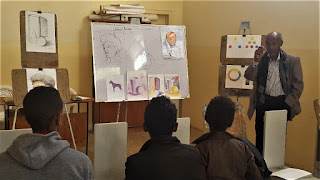Issayas: Dawit, I usually ask people to briefly tell us about themselves. Since you've written your memoir, I'll skip this part and ask you, why did you write your memoir? Or put differently, why would people buy and read your book?
Dawit: During his commencement address at Stanford University on June 12, 2005, Steve Jobs said,“You can’t connect the dots looking forward; you can only connect them looking backward. So you have to trust that the dots will somehow connect in your future. You have to trust in something—your gut, destiny, life, karma, whatever. Because believing that the dots will connect down the road will give you the confidence to follow your heart even when it leads you off the well-worn path, and that will make all the difference.” I needed to look back on the journey of my life hoping to find some pointers that I believed would help me deal with some parental challenges my wife and I were facing at the time. Within a short period, my wife, Monaliza Zerabruck Tewelde, and I became parents of three boys: Mieron was eight, Haben had just turned five, and Iyoba (Mathew) had been born a few days earlier. We later had two more children: Rutha (Laila) and Jacob.
When Iyoba was born in October 2005, for the first time after many years, I was afraid of the unknown. I was scared. I did not know what to do. Becoming a parent really made me want to take stock of my life, to remind me of who I am and who I had become. I needed an inspiration and I decided to search for my inspiration from within. For a first generation immigrant, what better place is there to search for inspiration than the journey traveled? I did find my inspiration within me and that helped me regained my confidence to follow my heart, as I have done in the past.
As I “connected the dots,” through the writing process, I learned that I had very little control over the outcomes and end results of my actions. And more, I observed a pattern of tremendous support from the great people I met along my way. I wanted to follow the Eritrean adage “To those who have done you favors, either return the favor or tell others about their good deeds.” Through the pages of Gratitude in Low Voices, I recognized and acknowledged the angels without wings who helped me, expecting nothing in return except the hope that I would eventually pay it forward.
I continued working on the Gratitude in Low Voices for over ten years because I wanted to get each story right, especially the ones pertaining to Eritrea and the struggle of the people of Eritrea. By the time readers get to the last page of Gratitude in Low Voices, I hope they had already identified concreted examples of how impactful our daily interactions are on each other. I hope they see how every positive human interaction has significantly higher effect on one another.
Gratitude in Low Voices is a human story and, as such, I hope readers will identify and related with the stories in the book.
Issayas: You've many footnotes in your memoir. I don't remember ever seeing that. Why did you decide to do that?
Dawit: As David Pool noted in his book Eritrea: Africa’s Longest War, published in 1982, “Eritrea was federated with Ethiopia in 1952 not because of the proofs of history but because the Ethiopian version fitted the interests of the foreign powers which decided the future of Eritrea after the defeat of Italy in the Second World War.” As such, Eritrea was annexed with Ethiopia without giving any consideration to the wishes and aspirations of Eritreans. To justify this historical blunder and miscarriage of justice, Ethiophiles had been working hard in re-writing history for many years. To dispel the disinformation and narratives that span multiple generations, we are forced to invest our valuable time and effort to get each story not only right but also properly referenced. I believe my approach will give future generations to use Gratitude in Low Voices as a reference book and work on expanding and providing in depth analysis of the various mini stories and points of references.
Issayas: Since Eritrea's experience to survive and excel is not only the story of Eritrea, but also the story of the human resilience and tenacity, I believe that Eritrea (Eritreans) are not writing their stories (narratives) as they should. Do you agree? If you do, what should be done?
Dawit: When it comes to Eritrean’s resilience and perseverance, the effort put so far to write our stories is paramount to “emptying the ocean with a spoon.” We have to speed up writing the “hero’s journey.” The good and sad part of the story of Eritrea and Eritreans is that before the older generations' “hero’s journey” is written with its proper context and historical reference, the new generation already is making its own history. One bigger than the other, yet both larger than life! We need a template of our “hero’s journey” and start working on telling our stories en-mass. I hope Gratitude in Low Voices will play a minuscule role in this manner.
Issayas: Thank you, Dawit. Good luck with the book and we'll re-connect again soon.
Dawit: You're welcome.






















































